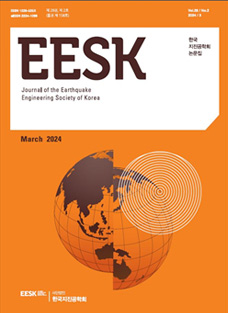1. Introduction
Liquid storage tanks are used for several applications like in chemical industries, nuclear plants and lifeline facilities [1]. In case of chemical plants, storage tanks are used to store hazardous liquid, therefore, seismic risk in such areas is higher as compared with other structures, even minor damage induced by the earthquake may have uncontrollable consequences not only on the structural facilities but also on the environment [2, 3]. Past earthquake history shows that damage on tanks may lead to temporary loss of essential services, this may happen for lifeline facilities like water supply system and in case of chemical industries besides structural failure, they may cause leakage and fire [4]. Large capacity storage tanks are subjected to dynamic loadings during an earthquake. Steel tanks have shown some negative consequences during the strong earthquake in the history causing overturning, sliding, buckling, roof damage etc [5]. There are a number of literature for the seismic evaluation of the liquid storage tanks and most of the codes are written based on the simplified theory expressed by the mass-spring equivalent system proposed by several references [6-8]. The theoretical concept from the literature is adopted in the seismic codes for liquid storage tank analysis [9, 10]. Housner’s mass-spring model divides the liquid contents of the tank into two masses, convective mass at the upper portion of liquid and impulsive mass at the lower portion [7].
The convective mass exerts convective hydrodynamic pressure on the tank wall and base, and the lower level impulsive mass which behaves as rigidly connected mass on the tank wall accelerates along with wall inducing hydrodynamic pressure on tank wall and base [7]. Malhotra et al. have proposed a simplified method whose work was based on the reference [11] by considering the higher mode of impulsive mass as first impulsive mass and higher mode of convective mass with first convective modal mass [6]. For accurate seismic evaluation, it is essential to include complex FSI (Fluid-Structure Interaction) phenomenon in the analysis. To date, numerous studies have been done for seismic behavior and vulnerability assessment of liquid storage tanks considering FSI models and simplified masssprings models, but most of these studies are done independently Before conducting failure probability analysis like fragility functions, it is very important to check the validity of simplified models. Validation of simplified models could be done by comparing their seismic results with detailed FSI model. In this research, three FE (Finite Element) simplified models namely cantilever mass-spring model (Type A), frame mass-spring model (Type B) and shell mass-spring model (Type C) are proposed, based on the analytical procedures suggested on the codes [9, 10] and literature [7], [8], [11]. These proposed FE models were checked and validated with FSI analyses results. In the FSI analysis, fluid-structure interaction phenomena are considered with the flexible tank wall. Seismic response of two types of steel storage tanks was considered with aspect ratios (H/D) of 0.4 and 0.86, here considered as broad and slender tank respectively.
In this paper, the comparative studies of 3D FSI model and simplified models were done under artificially generated earthquake ground motions. Accordingly, validation of proposed simplified models that are cantilever mass-spring model, frame mass-spring model, and shell mass-spring model were done based on the FEM (Finite Element Model) results. All FEM results are compared with analytical results from current code practice, IITK-GSDMA [11] and simplified procedure from Malhotra et al. [6]. Seismic analyses were performed with modal analysis followed by a time history analysis.
2. Finite Element Model Formulation
From the definition of classical potential fluid theory for the ideal fluid, the pressure wave equation of the fluid system can be written in the form of a three-dimensional space (x,y,z) given as
where, p = p(x,y,z,t) is the hydrodynamic pressure. The hydrodynamic pressure in equation (1) is due to the seismic excitation on the wall and bottom of the container [13]. The approximate boundary condition at the interface of the liquid and wall is governed by(2)
where, ρ is the density of liquid, an is an acceleration on the boundary along the direction outward normal, no wave absorption is considered at the interface boundary. For FSI analysis the fluid matrix and structural matrix are coupled using the general dynamic equation [14] given as(3)
where, Ms and Mf are the structural and fluid mass matrix respectively, Cs and Cf represent structural and acoustic damping matrix respectively, Ks and Kf are structure and fluid stiffness matrix, Fs and Ff are vectors of applied structure and fluid loads respectively, U is the vector of unknown nodal displacements, P is the vector of unknown nodal acoustic pressures and R stands for coupling matrix. The motion of the free liquid surface decays due to damping force created by the viscous boundary layers. Damping coefficient depends upon liquid height, liquid kinematic velocity and tank dimensions. For the acoustic liquid model with impulsive and convective parts, damping matrix can be given as
where, a and b are computed by Rayleigh damping method. In the above equation, [G] and [H] are the constants and coefficient a and b are calculated based on the fundamental frequency of convective and impulsive response [22]. Based on equation (4), simplified FEM modes are assigned with impulsive and convective damping separately. In the FE procedures of this study structural damping ratio equivalent to 5% is taken.
2.1 FSI model formulation
Tank wall is modeled by shell elements and liquid by acoustic elements called FLUID 80 in ANSYS [15]. These shell and acoustic elements make appearance of pressure and displacement degree of freedom at the fluid-wall interface. Coupling of acoustic pressure and structural motion at the interface has been taken into consideration in the governing equation for acoustics. The acoustic fluid and the structure interact with each other via coupling boundary condition. The behavior of the fluid is represented by the Lagrangian approach [21], and fluid is assumed to be incompressible, irrotational and inviscid [12]. This element is suitable to execute fluid-structure interaction and fluid sloshing [16]. As it is necessary to perform FSI, the coupling of the deformable layer with internal fluid is made by introducing FSI layers, whereas to find the sloshing behavior of the liquid in the tank, the free surface is introduced on the top of the liquid surface in finite element model. The impulsive pressure is associated with the impulsive movement of the wall which is proportional to the ground acceleration and the convective pressure is the result of the oscillation of the upper fluid layer because of impulsive movement. As the impulsive and the convective components have large frequency differences these two actions can be considered as uncoupled [11], [17].
2.2 Simplified model formulation
The basic idea of simplified model is based on spring-mass model proposed by Housner [18]. Two types of masses are defined that correspond to fluid behavior, impulsive fluid which moves along with tank as it responds to ground motions, and the convective fluid which oscillates fluid at the top of the tank due to the consequences of impulsive fluid movement due to ground motions. The impulsive fluid mass is rigidly attached at the tank wall, so rigid links are assigned to represent the impulsive fluid mass behavior. The convective mass is modeled by connecting with the link element to the beam member. Stiffness for these links are defined so as they allow for separate movements of the convective fluid during vibration. Damping ratio for impulsive mode is taken as 2% and for convective mode as 0.5%. Three different simplified models are proposed for the study namely cantilever mass-spring model (Type-A), frame mass-spring model (Type-B) and shell mass-spring model (Type- C). In case of Type-A model, a single beam element is used to model tank with the sectional stiffness equivalent to cylindrical tank and corresponding impulsive and convective masses are assigned at their respective heights. The convective mass is assigned by connecting with linear link element and as the impulsive mass acts as rigid mass, it is assigned to the beam element. Type -B modeling is done as frame element with convective and impulsive masses attached by linear convective links and rigid links respectively. Tank stiffness in Type-B model is divided into each beam element. Type-C modeling is done by considering empty cylindrical tank assigned with corresponding masses through convective and rigid links to the tank shell. The parameters associated with these simplified models are calculated based on the IITK-GSDMA code and Malhotra’s study which is adopted on the Eurocode 8 [19].
3. Numerical studies
Firstly,3D FSI analysis has been performed for the broad and slender steel tanks. Secondly, analyses were performed with simplified models, cantilever mass-spring model (Type- A), frame mass-spring model (Type- B) and shell mass-spring model (Type-C) under identical seismic conditions. Two tanks with height to diameter (H/D) ratios of 0.4 and 0.86 were taken to represent broad tank and slender tank. FEM idealization of the FSI models are shown in Figs. 1 and 2. The mechanical properties of the tanks are summarized in Table 1. For FSI approach, the model dimension for the slender tank is taken from the literature [20], FSI modal result validation is done with this literature results. The effect of tank wall flexibility and sloshing of fluid are considered. Mechanical parameters for simplified models are listed in Table 2. These parameters are calculated from the IITKGSDMA code [10] and Malhotra et al. analytical procedure [6]. Fig. 3(a), (b) and (c) represent simplified models proposed in this study.
3.1 Modal analysis
Prior to time history analyses, modal analyses were performed for all models. Modal analyses for FSI models are carried out by the Block Lanczos method. The analyses were done for the liquid under filled conditions, both tanks were assumed to be filled around 90% of the tank’s volume. The first three impulsive and convective frequencies are obtained by using the higher mass participation ratio from modal analysis. The obtained results from the FSI model are compared with the proposed simplified modal results and analytical results from IITKGSDMA code and procedure from Malhotra et al. literature. Slender tank FSI modal results are compared with the results of literature [20] from which the slender tank geometry is taken for this study, this is to validate the FSI model procedure in the software ANSYS.
The mode shapes results are shown in Table 3 and first three vibration modes for FSI models are shown in Figs. 4 and 5, and the convective and impulsive modes of vibrations for simplified models are shown in Fig. 6. Natural frequencies differences between FSI and simplified models show that the impulsive frequencies of simplified models differ 0.75% with the results of FSI model for Type-A and Type-B model and 3% for Type-C model. As compared to IITK-code and Malhotra procedure the impulsive frequencies of simplified models differ by 8% for the results of all three simplified models. However, convective frequencies do not show remarkable differences between FSI, simplified and IITK-code and Malhotra procedure. Modal analyses results from Table 3 show that impulsive frequencies for broad tank is 1.74 times higher than those of slender tanks for FSI model and 1.85 times higher than those of simplified models. Similarly, as compared to IITK-GSDMA and Malhotra’s procedure impulsive frequency of broad tank is 1.82 times higher than that of slender tank. From Table 3 results we can see that, liquid convective frequencies are much lower than impulsive frequencies for both FSI and simplified models, so sloshing of the liquid tank is more easily excited when an earthquake occurs. During ANSYS simulation, some former frequencies which are very low are seen but it should be kept in mind that those frequencies are surface particle wave so cannot be taken as convective frequency, therefore in the program it is set to 0.1 to 1 Hz to capture convective frequencies. From Figs. 4 and 5 it can be observed that, when vibration frequency is greater than 1 Hz, the shell liquid coupling vibration occurs which can be noticed from the mode shapes of the system, called cos-θ beam type of vibration [23]. Fig. 6 (a), (b) and (c) illustrate first convective and impulsive mode shape for cantilever mass-spring, frame mass-spring model and shell massspring model respectively, whose frequencies are equal to the first convective and impulsive mode frequencies of FSI model. This concludes that the modal FE analyses results in natural frequencies are very close for both FSI and simplified models.
3.2 Time history analysis
This numerical study is based on the chemical industry site situated in Ulsan, South Korea. Strong ground motions records are very few in this region, therefore input ground motion is developed as an artificial ground motion for this study. The horizontal earthquake motions for 18secs were generated with peak ground acceleration (PGA) of 0.154g for the rock site, which are suitable for seismic analysis for this region. The seismic excitations compatible to the design response spectrum specified in the Korean common seismic design code are generated using SIMQKE program [24]. For generating spectrum density function, envelope function from the code is used with short period of 0.02s and long period of 3.0 s. The time step size of 0.01s is used. Four random ground accelerations were generated, and the maximum ground acceleration is used for this study. Fig. 7(a), (b) and (c) represent artificial seismic waves. The generated acceleration time histories were converted into displacement time histories and applied on FSI model. On the other hand acceleration time histories were applied for simplified models. The examined responses of the broad and slender tanks to transient loading include base shear and overturning moment. Comparison of results for FSI model and proposed simplified models for broad and slender tanks are summarized in Table 4 and 5 respectively. Considering FSI model as an accurate, simplified models results are estimated to be about 3% less than the FSI model result for base shear and, IITK-GSDMA and Malhotra et al results are estimated as 3% and 1% more, respectively. In the case of overturning moment, simplified model results are estimated as 3-9% larger than FSI model ones and, IITK and Malhotra et al. results are estimated as 13% and 8% more, respectively. In case of slender tank, simplified models’ results are estimated to be about 3%-6% higher than the FSI model result for base shear and, IITK-GSDMA and Malhotra et al results are estimated as 8% and 5% more, respectively. For overturning moment, simplified model results are 3% less on beam model and 3% higher in shell model as compared to FSI model results and, IITK-GSDMA and Malhotra et al results are estimated as 3% and 13%, more, respectively.
Figs. 8-11 illustrate the comparison of convective and impulsive base shear and overturning moment for time history analyses of FSI model. In the broad tank, the impulsive component has base shear of about 18 times larger than the convective component, and the overturning moment is about 20 times larger. In the slender tank, impulsive component has base shear about 41 times greater than convective component and for overturning moment impulsive component is 38 times larger than convective component. This concludes the contribution on seismic force from impulsive component is higher than that from convective component. For all models, overall resultant base shears and overturning moments are obtained by using SRSS combination. The time history SRSS combination of proposed simplified models (Type -A, B and C) shows good agreement with the FSI model results. This can be observed from Figs. 12 and 13. Fig. 9, 10
4. Conclusions
In this study, modal analyses and time history analyses were carried out to investigate the quantitative results differences between the FSI model, simple mass-spring model, and lumped-mass shell model for steel storage tanks of different aspect ratios representing broad and slender tanks. The conclusions drawn from this study are given below.
-
1) Convective frequencies for both slender and broad tanks considered in this study were very small, which indicates sloshing on the reservoir gets easily excited on minor earthquakes.
-
2) The first impulsive frequency of broad tank is 1.74 times that of slender tank in modal analysis with FSI model, and it is 1.85 times in anlyses with simplified models in modal analyses. As compared to code provision it is 1.82 times higher. This concludes that the broad tank is stiffer than slender tank during seismic vibration.
-
3) In time history analyses with FSI model, the impulsive base shear is 18 times that of convective component in broad tank, and it is 48 times in slender tank. Similarly, the impulsive overturning moment is 19 times that of convective component, and it is 37 times in slender tank. This concludes that tanks experience maximum seismic response due to impulsive pressure distribution.
-
4) The base shear results of broad tank with simplified models of Type-A and Type-B are 3% lower than that from FSI model, and it is 1% higher in Type-C model. Overturning moments are 5%, 3% and 9% higher than that of FSI model in Type-A, Type-B and Type-C models, respectively. On other hand, in slender tank, base shears are 3%, 3% and 6% higher than that from FSI model in Type-A, Type-B and Type-C model, respectively. Overturning moments from Type-A and Type-B models are 3% less than that from FSI model but it is 3% higher in Type-C model. From the quantitative analyses it can be concluded that the simplified models results show good agreement with FSI results.
-
5) The three types of simplified models in this study showed good agreement with the FSI model results, code and literature-based analytical values. This verifies that the current practice of using simplified models for seismic response analyses is valid for ground supported cylindrical tanks. Hence, the simplified models proposed here can be used as representative models for cylindrical storage tanks in failure probability analysis.
Nomenclature
-
h : Maximum depth of the liquid
-
hi : Height of the impulsive mass above the bottom of the tank
-
hi : Height of the convective mass above the bottom of the tank
-
hc ′ : Height of the convective mass above bottom of the tank wall(considering base pressure)
-
hi ′ : Height of the impulsive mass above bottom of the tank wall(considering base pressure)
-
mc : Convective mass of the liquid
-
mi : Impulsive mass of the liquid
-
ms : Mass of the container
-
kc : Spring stiffness of convective mode
-
krigid : Spring stiffness of impulsive mode
-
Cc : Coefficient of time period for convective mode
-
Ci : Coefficient of time period for impulsive mode
-
Tc : Time period for convective mode (in seconds)
-
Ti : Time period for impulsive mode (in seconds)
-
*Con. : Convective
-
*Imp. : Impulsive
-
*Ot. : Overturning






























